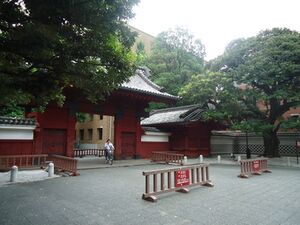Difference between revisions of "Kaga Edo mansion"
| Line 2: | Line 2: | ||
*''Japanese'': 加賀江戸藩邸 ''(Kaga Edo hantei)'' | *''Japanese'': 加賀江戸藩邸 ''(Kaga Edo hantei)'' | ||
| − | The main [[daimyo yashiki|mansion]] of [[Kaga han]] in [[Edo]] covered roughly 267 acres, filled with warehouses, barracks, residences, gardens, and schools, and inhabited by as many as 30,000 people.<ref>[[Albert M. Craig]], ''The Heritage of Japanese Civilization'', Second Edition, Prentice Hall (2011), 72.</ref> The space is today the main campus of the [[University of Tokyo]]. | + | The main ''kami-yashiki'' [[daimyo yashiki|mansion]] of [[Kaga han]] in the Hongô neighborhood of [[Edo]] covered more than 100,000 ''[[Japanese Measurements|tsubo]]'' (roughly 267 acres), filled with warehouses, barracks, residences, gardens, and schools, and inhabited by as many as 30,000 people.<ref>[[Albert M. Craig]], ''The Heritage of Japanese Civilization'', Second Edition, Prentice Hall (2011), 72.</ref> The space is today the main campus of the [[University of Tokyo]]. The famous red gate (''akamon'') still standing on the university campus was originally built in [[1827]] for the occasion of the marriage of Kaga daimyô [[Maeda Nariyasu]] to [[Yohime|Yôhime]], 21st daughter of Shogun [[Tokugawa Ienari]].<ref>Craig, 78.; "[http://www.seisonkaku.com/english/tenjisitu/meihin5.html Embroidered Costume on Pale Blue Crepe]," [[Seisonkaku]] official website.</ref> The gate, originally known as the ''goshudenmon''<!--御守殿門-->, is today a registered [[Important Cultural Property]].<ref>Plaques on-site.</ref> |
The lord of Kaga han typically [[sankin kotai|arrived in Edo]] with an entourage of 8,000, leaving roughly 4,000 behind afterwards to help manage his estates. | The lord of Kaga han typically [[sankin kotai|arrived in Edo]] with an entourage of 8,000, leaving roughly 4,000 behind afterwards to help manage his estates. | ||
| − | The | + | While the lord resided at the ''kami-yashiki'', the domain maintained three other mansions in the city. The ''naka-yashiki'' ("middle mansion") in Komagome covered over 20,000 ''tsubo'', and the ''shimo-yashiki'' ("lower mansion") at Itabashi covered nearly 200,000 ''tsubo''. A ''kakae-yashiki'' at Fukagawa, meanwhile, covered less than 3,000 ''tsubo'', and served mainly to manage areas of rice fields which contributed to supporting the feeding and funding of the other mansions.<ref>Gallery labels, "Upper, Middle, and Lower Residences of Kaga Domain," National Museum of Japanese History.[https://www.flickr.com/photos/toranosuke/12591023803/sizes/h/]</ref> |
{{stub}} | {{stub}} | ||
Revision as of 12:10, 15 September 2015

- Japanese: 加賀江戸藩邸 (Kaga Edo hantei)
The main kami-yashiki mansion of Kaga han in the Hongô neighborhood of Edo covered more than 100,000 tsubo (roughly 267 acres), filled with warehouses, barracks, residences, gardens, and schools, and inhabited by as many as 30,000 people.[1] The space is today the main campus of the University of Tokyo. The famous red gate (akamon) still standing on the university campus was originally built in 1827 for the occasion of the marriage of Kaga daimyô Maeda Nariyasu to Yôhime, 21st daughter of Shogun Tokugawa Ienari.[2] The gate, originally known as the goshudenmon, is today a registered Important Cultural Property.[3]
The lord of Kaga han typically arrived in Edo with an entourage of 8,000, leaving roughly 4,000 behind afterwards to help manage his estates.
While the lord resided at the kami-yashiki, the domain maintained three other mansions in the city. The naka-yashiki ("middle mansion") in Komagome covered over 20,000 tsubo, and the shimo-yashiki ("lower mansion") at Itabashi covered nearly 200,000 tsubo. A kakae-yashiki at Fukagawa, meanwhile, covered less than 3,000 tsubo, and served mainly to manage areas of rice fields which contributed to supporting the feeding and funding of the other mansions.[4]
References
- ↑ Albert M. Craig, The Heritage of Japanese Civilization, Second Edition, Prentice Hall (2011), 72.
- ↑ Craig, 78.; "Embroidered Costume on Pale Blue Crepe," Seisonkaku official website.
- ↑ Plaques on-site.
- ↑ Gallery labels, "Upper, Middle, and Lower Residences of Kaga Domain," National Museum of Japanese History.[1]